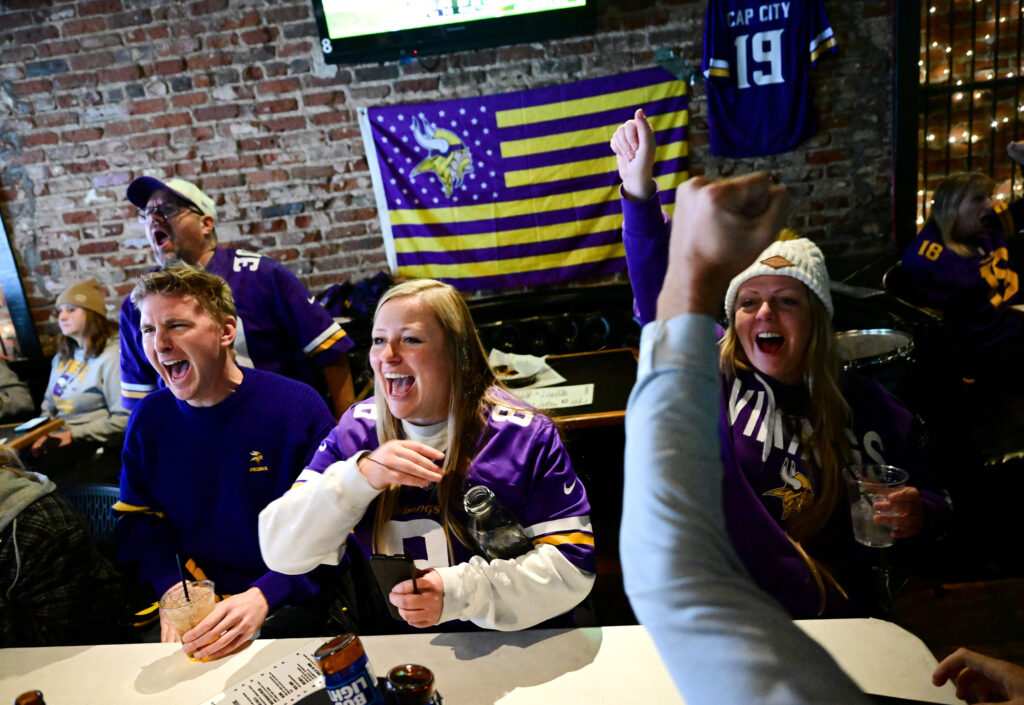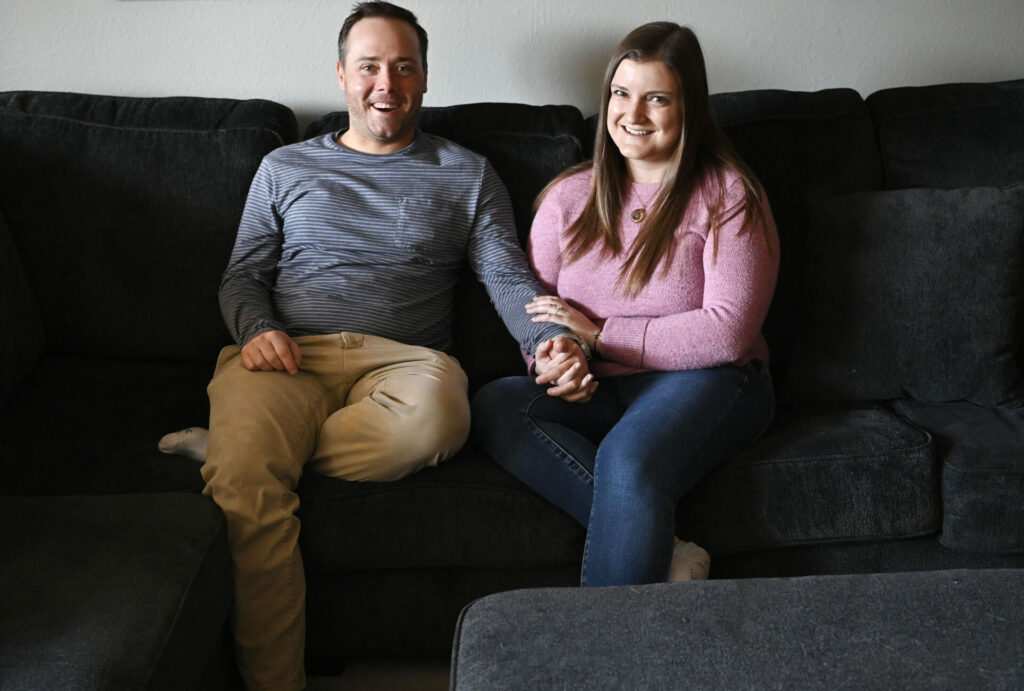Dino McTaggart, a native of Cleveland, moved to Denver in 1997 for the love of a woman.
Eleven years later, the 55-year-old channeled his adolescence working at his father’s bar to create a space for Midwesterners to rub elbows — and, more importantly, drink beer — downtown: Cap City Tavern at 1247 Bannock St.
The successful business model of serving the state’s population of Midwestern migrants has resulted in other spots like Badgers Pub and Wally’s Wisconsin Tavern popping up throughout the city to please newcomers, with almost 44,000 moving to Colorado from the region’s 12 states from 2021 to 2022.

Although Californians and Texans have historically led the charge in leaving their respective states for the Rocky Mountains, the pipeline from the Midwest to Colorado proves to be a reliable source of tens of thousands of new residents year after year. Their reasons vary, whether it’s to enroll at a Colorado university, escape to better climates or connect with nature.
But with Midwesterners historically shaping the state into what it is today, it raises the question: Is Denver destined to eventually become the next Chicago, metropolis of Middle America?
McTaggart doesn’t think so. He also doesn’t foresee Midwesterners staying put in their home states anytime soon.
“I love Denver for its weather and its people,” he said.
When McTaggart and a partner bought Cap City Tavern during the Great Recession, it served as the territory of Nebraska Cornhuskers football fans on Saturdays, which “allowed us to pay our rent and keep going,” he said.

Eventually, to churn up business on Sundays, they decided to adopt an NFL football team, and an allegiance to the Minnesota Vikings was born. One game between the Vikings and the Green Bay Packers, they found themselves standing room only.
“We sold our souls to Minnesota,” McTaggart said.
Fans of all ages now cram into the bar to cheer on their favorite team, with regulars settling into their usual seats.
He recalls “a customer of ours who became part of our family,” hitting a snare drum during games to rile up customers into the Viking chant of “Skol!” The man recently passed way, and his daughter now carries on the tradition.
“Even if they’re losing — and the Minnesota Vikings are a classically awful team, they always lose — Minnesotans just want to be with other Minnesotans,” McTaggart said.
Which states are Midwestern?
One controversial topic for Midwesterners is determining which states actually make up the region.
Illinois, Indiana, Iowa, Michigan, Minnesota, Ohio and Wisconsin are solidly Midwestern states. In addition to them, the U.S. Census Bureau also classifies North and South Dakota, Nebraska, Kansas and Missouri as Midwestern states. Those areas have a lot in common with the other Midwestern states — particularly the friendliness of the people — but the residents who live on the High Plains often find more kinship with the states to their west, and Missouri can be considered a Middle America, southern hybrid.
The agency considers Colorado a state in the Mountain West.
From 2021 to 2022, California had the most residents move to Colorado over a one-year span with more than 33,000 people, followed by more than 25,000 from Texas. The No. 3 state was Florida at over 11,000, followed by Illinois at over 9,000 and New York at about 8,500.
It’s worth noting that four out of five of those states also have the largest populations in the country: California at close to 39 million, Texas at almost 30 million, Florida at 22 million and New York at over 19 million.
As a region, the Midwest contributed almost 44,000 new Coloradans across its 12 states, with Illinois at the top, then Missouri with 6,100 and Ohio with almost 5,000.
But a decade earlier, from 2010-11, these patterns saw more divergence. California barely held in the top spot with 23,000 people moving to Colorado, followed by Texas at 22,000, Arizona at 12,000, New Mexico at almost 9,000 and Florida at 8,000. Still, the Midwest remained a consistent contributor with almost 44,000.
Over 40,000 Midwesterners resettled in the Centennial State from 2005-06, making it a steadfast source of future Coloradans for the past 17 years.
While Arizona and Florida entice older adults and Texas draws mid-career workers, Colorado attracts young people “based on job growth,” state demographer Elizabeth Garner said. “We have a tighter labor force than other states.”
For example, a contributing factor for Illinois residents moving to Colorado has historically been the state outperforming Illinois economically, Garner said.
But she wouldn’t call it an influx of Midwesterners — “more like a steady flow.”
She’s anticipating similar migration patterns in the future, “but it will really depend on job growth and relative competitiveness,” Garner said.
Jordyn Reiland, 30, is a newcomer to Denver. The Illinois native moved to Colorado in March from Chicago with her fiance Aaron Sidrow.
They met in late 2019 on dating app Bumble, and their relationship blossomed through the COVID-19 pandemic. Sidrow, a 31-year-old originally from Littleton, lived in Chicago because of his job at the time as a pilot at SkyWest Airlines.
He “really started to notice what Chicago kind of lacked during the pandemic,” Reiland said, as museums and restaurants remained shuttered, with nowhere to go on chilly, windy days.
In 2021, they started weighing their options for a potential move, considering both Salt Lake City and Denver. Reiland described herself as hesitant to leave, given her family roots in Illinois and fondness for Chicago.
But once she visited Denver, she changed her mind, falling in love with the access to the outdoors and the weather. Throughout the process, Reiland leaned on a friend who had moved to Fort Collins from Chicago a year earlier.
She’s still needed time to adjust. For instance, in Chicago, “I never drove my car, and, unfortunately, that’s just not really possible in Denver still, regardless of the light rail and the buses,” she said.
Still, “it’s nice to see the sun” in Colorado, Reiland said. She considers Denver “something that’s different enough from the Midwest, but it still has that little bit of familiarity.”
University recruitment of Midwesterners
Some Midwesterners move to Colorado in their youth as they pursue college degrees in the Rocky Mountain West — and, then, build their lives here.
Heather Daniels, executive director of Colorado State University’s Office of Admissions, understands that draw as a resident of 10 years who’s originally from the Chicago area.
“The opportunity to take advantage of everything that Colorado has to offer is appealing to students coming from the Midwest,” she said.
Daniels describes the state as “close enough that even the long drive is manageable,” with many affordable flight options. “I think that our students love the opportunity to explore a new environment, community and way of living,” she added.
At CSU, the 12 states of the Midwest region contributed almost 2,200 undergraduate students for this year’s fall semester, with the highest numbers from Illinois at about 800 and Minnesota at over 300, according to its Office of Institutional Research, Planning and Effectiveness.
That’s more combined than the 2,100 undergraduate students from California and 1,100 from Texas, with a total of more than 24,000 undergrads at CSU. Midwesterners made up 10% of first-year students to apply, and 9% of enrolled students.
One of the university’s regional recruiters is in the Chicago area, covering Illinois, Indiana, Michigan and Wisconsin, while another counselor travels throughout Iowa, Minnesota, Missouri, Nebraska, Kansas and Kentucky to connect with prospective students.
The University of Colorado Boulder typically recruits prospective students from Illinois, Minnesota, Indiana and Ohio, expanding this year to include Missouri and Wisconsin, spokesperson Nicole Mueksch said.
“Illinois tends to be one of our top represented states among our first-year classes,” Mueksch said. It ranked as the No. 3 state for the fall 2023 and fall 2022 first-year classes — and the No. 2 state for the entire fall 2022 out of the state undergraduate population.
This year, about 8% of the university’s undergraduate first-year student population hailed from the Midwest, with 579 students representing all of the region’s states except for South Dakota. The top three states ranked as Illinois, Minnesota and Ohio.
That’s a slightly higher percentage than a decade earlier when Midwestern students made up about 7% of the first-year undergraduate class of 2013, with 395 students. Still, the top states remained the same.
“In addition to the strong academic programs our campus provides, prospective students from the Midwest have expressed interest in attending CU Boulder to be in close proximity to the Rocky Mountains for outdoor recreation activities like skiing and snowboarding,” Mueksch said.
The college also “provides them the opportunity to attend a state school that is smaller in student population than some of their in-state options,” she added.
“We’re still here”
Sam Gettleman, 30, first considered a move to Denver after looking at CU Boulder and the University of Denver as potential college options. Ultimately, the native of Deerfield, Ill. — a “quaint suburbia” outside of Chicago, he said — opted for Miami University in Oxford, Ohio.
Gettleman “basically spent the first 22 years of my life in that gray weather that I just kind of accepted,” he said.
But Colorado never strayed far from his mind. He’d stay at a family friend’s home in Vail during his spring breaks to ski and snowboard.
Then, in late 2015, he received a text from his best friend who quit his job in Cincinnati and planned to resettle in Denver.
At the time, Gettleman only knew a few Midwestern friends in the area — all of whom decided to go to college in Colorado and stay after graduating. He considered it a nontraditional choice for Midwesterners, outlining the typical path as attending one of the Big Ten Conference universities, joining Greek life and securing a job in Chicago.
But he signed a six-month lease in Denver anyway, with a back-up plan to move home to Deerfield if it didn’t work out.
“We’re still here, coming up on eight years later,” Gettleman said. A resident of the Capitol Hill neighborhood, he’s fond of its walkability, with easy access to both green space and downtown.
So, is Denver destined to turn into the next Chicago? Gettleman disagrees.
Real estate developers would “need to build up and out so much to catch up to Chicago, but I think that’s a good thing,” he said.
“The stereotypical thing of Colorado is, it’s just a lot more laid-back,” Gettleman said. Denver is “a lot quieter, but you still have that city feel, which is what I love.”
___
© 2023 MediaNews Group, Inc
Distributed by Tribune Content Agency, LLC.



